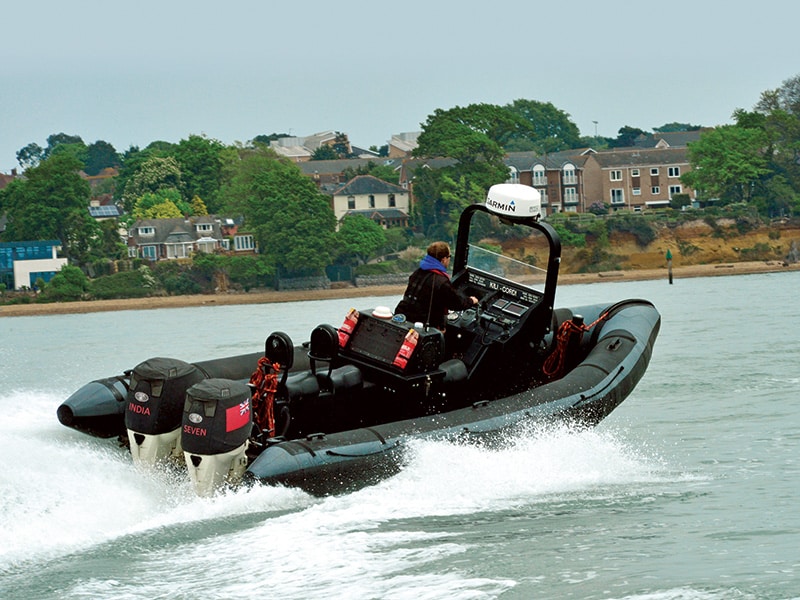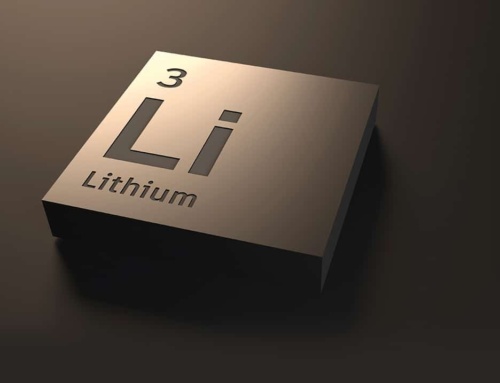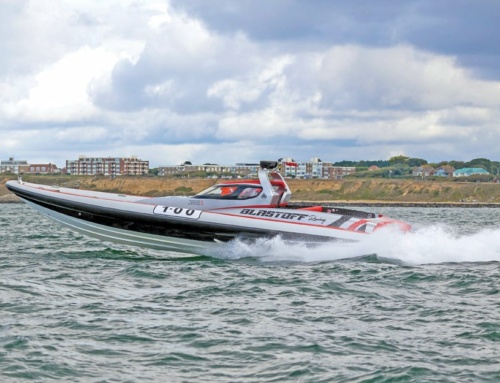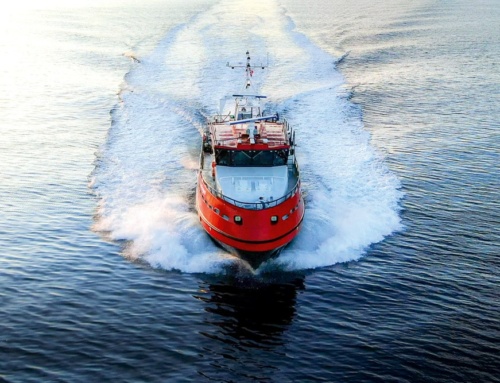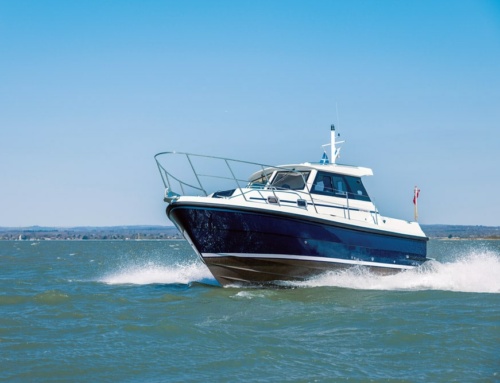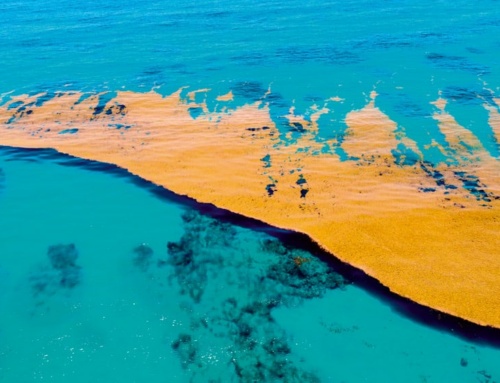- You have no doubt about the hull’s credibility as it simply runs through any chop with total indifference.
- The ride is unsurprisingly smooth, helped by the thick supportive seating.
- The Arctic is no sprightly race boat, but the punchy 2-stroke E-TEC motors still push her quickly up onto the plane.
- They are constructed like a battleship …
Greg Copp reports on the refitting of an ex-military monster packed with power and punch …
Constructed for the Royal Navy and Marines, these Halmatic-built boats have a formidable reputation. Many, like this particular boat, were used by the Special Boat Service for operations that do not get flagged up in the media. Consequently they are built to be abused like no other RIB, apart from their fellow Halmatic siblings. One of the criteria for these boats is that they need to comfortably suffer being parachuted from a Hercules C-130 (without occupants!), which they easily took in their stride during their service to the Crown.
Normally they were built with a triple inline jockey seat set-up – not surprisingly with foot straps. They are constructed like a battleship, which is evident if you have ever seen one with its heavy wooden deck removed. The hull is a close network of full-height stringers and cross members that leave you in no doubt about what this boat can take. The tubes are the finest heavy-duty Hypalon and are heavily armoured. People are often concerned about buying these boats due to the use they may have suffered, but rarely are they found with serious structural damage, as it is normally internal fittings and the engines that suffer. The original power options were generally twin 2-stroke long-shaft 135hp or 150hp Mercury Mariners, which, depending on loading, would push the Arctic 22 to between 40 and 50 knots. Fuel capacity was normally 270 litres in two tanks. Most in civilian use have now been repowered with a newer, more frugal set of engines. They are also rated for a single 250hp extra-long-shaft engine, though I have only come across this engine set-up where the boat has been repowered in civilian use.
They are built with a super-heavy-duty aluminium transom plate to take the weight and power of two middleweight engines, which relatively speaking is a lot for a 6.5m RIB. This plate has deck-level channels on each side, enabling the boat to self-drain – an alternative to elephant trunks. This is a great idea but can cause the boat to backfill with water at low speed. These boats were subsequently eclipsed by the Arctic 24 and Arctic 28, which is why many of these interesting craft have ended up in private ownership.
Will’s boat
Will’s Arctic 22 left military service some 15 years back, when the MOD was uprating to Arctic 24s. She was relatively young for an ex-MOD boat, having not been in service long, and so was ready for an easy conversion to civilian use. Her first owner was someone living on the Isle of Wight, who bought her as a water taxi to go to the mainland. At this stage the twin military outboards were replaced with just one 200hp Mercury Optimax, and a one-man cabin was installed over the original in-line console … Yuk! This was not really in keeping with character, so when Will’s company, Ambex Marine, bought her in 2012 the wheelhouse had to go. A 100% refurbishment was in order, which included removal of the sponsons. They were reconditioned and then modified slightly (removal of loads of internal handles and storage bags) by Henshaw Inflatables of Wincanton. Henshaw made the tubes originally for Halmatic, and as they were renowned for working with Hypalon, they were the obvious choice.
The sponson attachment extrusions were removed, repaired, repainted and refitted. The extrusions enable the tubes to be easily extracted and repaired if need be. The original console was removed and disposed of, and a custom console and mast built – both totally in keeping with the boat’s character and the use intended for it. The new console provides the combined benefit of sociable seating for two plus the capacity for two more without eating into all the available deck space. This enabled a bit of fine-tuning of the ergonomics, like accommodating two stand-alone sets of electronics (plotters and radios) as well as locating the compass on the aft console so it could not be affected by the current feeding two radios, two chartplotters and a radar system.
The engines are electronically controlled Evinrude Generation 1 2-stroke E-TEC 150s, which were supplied and installed by Quinquari Marine in early 2013, and so far have approximately 50 hours of running behind them. They were recently serviced for the forthcoming season, though they have an incredible 300hour/3-year service interval. These motors are a logical choice if you want twin-engine security with minimal weight, as they are lighter than any similar-power 4-stroke engine. They also have a lot of low-down power, making them ideal for pushing the heavily constructed Arctic up onto the plane, and are just as economical as any modern 4-stroke outboard.
The fuel system and electrics were all new in 2013. The twin tanks hold 100 litres of petrol each and feed each engine independently. The original under-deck fuel tank is not used but is still in place. The electrical system comprises two batteries with a link facility should one circuit fail. All electrical loads are split across both banks to maintain redundancy. A comprehensive suite of modern electronics was also fitted during the refit, including a plotter from Simrad, a plotter from Garmin, twin Icom radios (the toughest RIB radio) and a digital radar system from Garmin. The radar mast is mounted forward rather than aft, which, apart from reducing weight in the stern area, does not clutter the aft deck and does not transmit over the heads of the crew.
Since the refit she has been used by Ambex Marine for testing a range of new electronic systems, including the gSense monitor. Built by Ambex Marine, gSense is a shock and impact monitoring system that provides a real-time display of the g loadings on board a vessel. Using three-dimensional accelerometer technology, gSense provides information that enables the boat driver to adjust boat handling or speed to stay within agreed parameters for the safety of the boat, crew and passengers. Typical applications for the gSense monitoring system include military craft, commercial vessels and high-performance race boats.
On the water
The Arctic is no sprightly race boat, but the punchy 2-stroke E-TEC motors still push her quickly up onto the plane. As her 1.6 tonnes are distributed well, she planes at a modest 18 knots. One thing that has not changed from the original Mercury engines is that lovely demonic snarl that the E-TEC 2-stroke engine, regardless of its modern fuelling system, emits under load. Having owned a boat with a big E-TEC, I am a fan of that distinctive 2-stroke howl, which never fails to turn heads when driven hard. Having the helm located forward gives a great view over the bow, perfect for reading every wave. In its original military form the helm location was much the same.
You have no doubt about the hull’s credibility as it simply runs through any chop with total indifference. The hull is sufficiently sharp to cut, and though it is relatively heavy for a 6.5m RIB, it does not react as many 22ft boats do when hitting the sea bow on. The ride is unsurprisingly smooth, helped by the thick supportive seating. It is also a very dry boat, as its super-thick spray rails, which serve to strengthen the hull, do a fantastic job of keeping the sea where it belongs. One thing is certain and that is that the Arctic 22 is reassuring to drive hard, and very responsive to the wheel – I was expecting it to be a bit lethargic in this area considering its military construction, but not so. Thirty-five knots is a very comfortable cruising speed, but with the punchy E-TEC power delivery you can’t help but push it to its top speed just shy of 50 knots and soak up its true ambience.
Now the boat is on the market again for £25,000 plus VAT.
Contact

